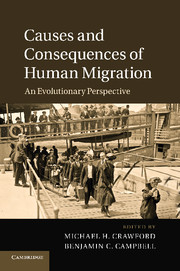Book contents
- Frontmatter
- Contents
- Contributors
- Preface
- 1 Perspectives on human migration: introduction
- Section 1 Theory
- Section 2 Geography and migration
- 8 Population structure and migration in Africa: correlations between archaeological, linguistic, and genetic data
- 9 Human migrations in North Africa
- 10 Identity, voice, community: new African immigrants to Kansas
- 11 The African colonial migration into Mexico: history and biological consequences
- 12 Demic expansion or cultural diffusion: migration and Basque origins
- 13 Consequences of migration among the Roma: immunoglobulin markers as a tool in investigating population relationships
- 14 Migration, assimilation, and admixture: genes of a Scot?
- 15 Mennonite migrations: genetic and demographic consequences
- 16 Human migratory history: through the looking-glass of genetic geography of Mycobacterium tuberculosis
- 17 Peopling the Tibetan plateau: migrants, genes, and genetic adaptations
- 18 Migration, globalization, instability, and Chinese in Peru
- 19 The great blue highway: human migration in the Pacific
- 20 Migration of pre-Hispanic and contemporary human Mexican populations
- 21 A review of the Tupi expansion in the Amazon
- 22 Molecular consequences of migration and urbanization in Peruvian Amazonia
- 23 Migration in Afro-Brazilian rural communities: crossing historical, demographic, and genetic data
- 24 Indentured migration, gene flow, and the formation of the Indo-Costa Rican population
- 25 Causes and consequences of migration to the Caribbean Islands and Central America: an evolutionary success story
- Section 3 Overview
- Index
- References
19 - The great blue highway: human migration in the Pacific
Published online by Cambridge University Press: 05 December 2012
- Frontmatter
- Contents
- Contributors
- Preface
- 1 Perspectives on human migration: introduction
- Section 1 Theory
- Section 2 Geography and migration
- 8 Population structure and migration in Africa: correlations between archaeological, linguistic, and genetic data
- 9 Human migrations in North Africa
- 10 Identity, voice, community: new African immigrants to Kansas
- 11 The African colonial migration into Mexico: history and biological consequences
- 12 Demic expansion or cultural diffusion: migration and Basque origins
- 13 Consequences of migration among the Roma: immunoglobulin markers as a tool in investigating population relationships
- 14 Migration, assimilation, and admixture: genes of a Scot?
- 15 Mennonite migrations: genetic and demographic consequences
- 16 Human migratory history: through the looking-glass of genetic geography of Mycobacterium tuberculosis
- 17 Peopling the Tibetan plateau: migrants, genes, and genetic adaptations
- 18 Migration, globalization, instability, and Chinese in Peru
- 19 The great blue highway: human migration in the Pacific
- 20 Migration of pre-Hispanic and contemporary human Mexican populations
- 21 A review of the Tupi expansion in the Amazon
- 22 Molecular consequences of migration and urbanization in Peruvian Amazonia
- 23 Migration in Afro-Brazilian rural communities: crossing historical, demographic, and genetic data
- 24 Indentured migration, gene flow, and the formation of the Indo-Costa Rican population
- 25 Causes and consequences of migration to the Caribbean Islands and Central America: an evolutionary success story
- Section 3 Overview
- Index
- References
Summary
Introduction
The Pacific region, defined here as the islands of the Pacific Ocean from New Guinea eastwards to Rapa Nui/Easter Island in the west and from Hawai’i in the north to Aotearoa/New Zealand in the south (Figure 19.1), is particularly interesting and valuable for studying human migration. There are a number of characteristics that make migration here unique: the timing of colonization, the varieties of environments that people encountered, the relative isolation compared with most continental regions and, perhaps most importantly, the fact that migration for most of the history of human occupation required crossing vast stretches of open ocean in some form of watercraft. However, both despite and perhaps because of the relative isolation of most Pacific islands, migration has always been a major feature of life.
The Pacific Ocean covers over a third of the earth’s surface, with an area of more than 165 000 000 square kilometers stretching nearly 20 000 km east to west. The total land mass of the Pacific Islands, however, is only about 1 262 000 square kilometers and more than half of that is taken up by New Guinea, the second largest island in the world. While many people in the world have and continue to view the ocean as a barrier, for Pacific peoples the open ocean has been the life force, the link to their ancestors and to their neighbors. It was a great highway, which, like many highways, at some times allowed people to move quickly and at other times restricted movement.
- Type
- Chapter
- Information
- Causes and Consequences of Human MigrationAn Evolutionary Perspective, pp. 388 - 416Publisher: Cambridge University PressPrint publication year: 2012
References
- 2
- Cited by

